How to Train a Pomeranian
Lateef Bhatti
Author
To train a Pomeranian successfully, one needs patience, consistency, and positive reinforcement. If you are wondering how to train a pomeranian begin with basic obedience commands. After this, focus on socialization and crate training. Keeping training sessions short and rewarding will match the Pomeranian’s energy and intelligence. After some time, the Pomeranian will be a well-mannered loving and, joyfully, willing to learn companion.
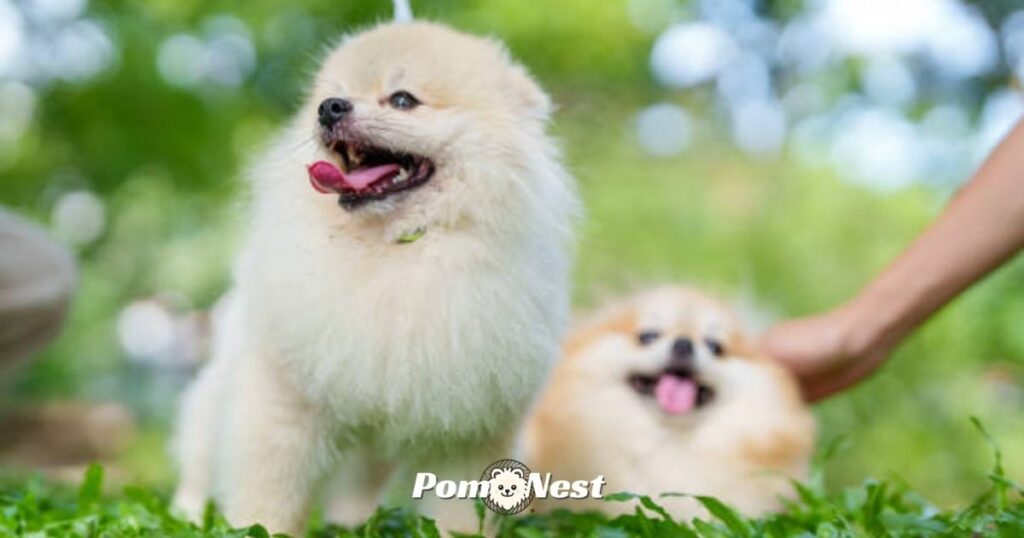
Training a Pomeranian can be a really enjoyable experience, but it does require a lot of patience, organization, and consistency. Understanding how to train a Pomeranian helps you develop a confident, happy, and well-adjusted companion. Get to know your Pomeranian so you can manage problem behaviors or teach basic commands effectively.
Table of Contents
ToggleHow to train a Pomeranian puppy
When you home your puppy Pom for the first time, it is best to start the how to train a Pomeranian process slowly. Puppies have very short attention spans, and the complexity of the task should be adjusted to avoid frustration. Training a Pomeranian puppy requires the right timing, a positive tone, and repetition of the task.
Make sure your home is puppy-safe and free of distractions. Your training area should be consist and free of distractions. Employ positive reinforcement. Use treats, praise, and gentle pats to reward behaviors you want to capture. This creates a positive association.
Having your Pomeranian puppy use the crate for house training will help establish a training routine and help to eliminate accidents. Avoid the common pitfall of punishment associated with the crate. Instead, create a comfortable, secure, and even cozy den crate to help your Pom relax. This and a few other training exercises will make the process of training a Pomeranian easier.
Begin socialization between 8 and 10 weeks of age. When socializing your Pomeranian, introduce them to new individuals and other pets, and to new sounds, carefully. This sort of positive exposure will help to avoid the development of fear-based aggression in the future. There will be many opportunities to win over a Pomeranian’s in the early stages of training, and every small win counts.
Finally, patience is necessary. Some Pomeranians learn the commands quickly, while others will need to be encouraged for a longer time. Even after the training for a given session has been completed, there is a need to encourage the dog to perform a command that the dog knows. This is necessary to foster trust that will be important in encouraging further training and for the development of long-term obedience.
🧠 Are Pomeranians Easy to Train?
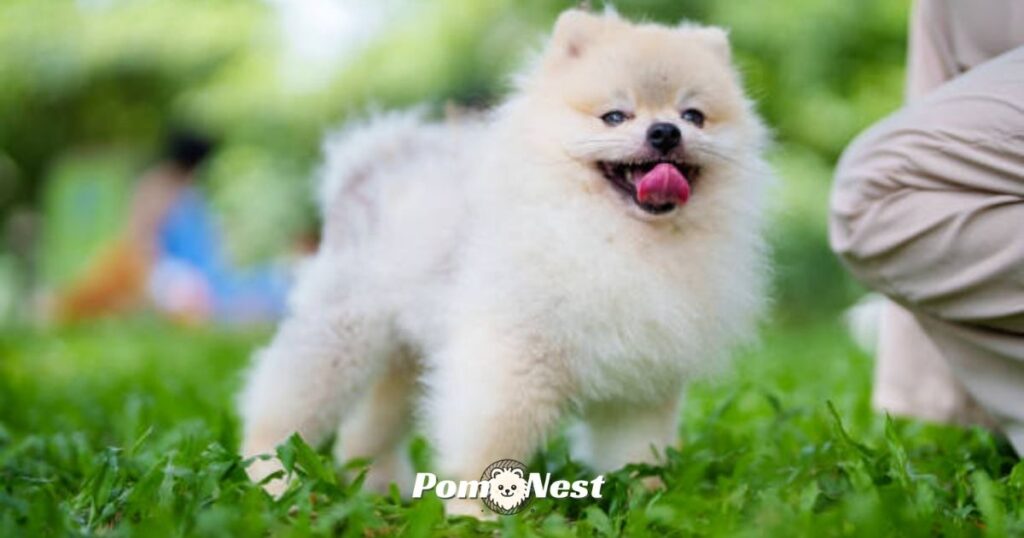
Though Pomeranians are clever, they are renowned for their stubbornness as well. The training process “how to train a Pomeranian” requires a gentle yet assertive approach. Pomeranians tend to view training as a fun game rather than a monotonous task.
Positive reinforcement works very well Pomeranians as they are eager to please their owners. Pomeranians are attention seekers, so they will do almost anything for praise and attention. Reinforce commands with praise, and do not scold your Pomeranian. Appeasing destructive behaviors will not work, and your Pomeranian will become distrustful and aggressive.
With Pomeranians, you cannot expect to be inconsistent regarding behaviors. For example, if you allow barking on one occasion and the next you don’t and expect your Pomeranian to comply, this will result in confusion. Once you have established a silent command, use the same verbal command each time. This will result in training success.
To answer this question: Pomeranians are the easiest to train. It simply depends on their personality. Pomeranians have an exuberant spirit and with patience and repetitions, they can be trained to follow commands.
🧺 Preparatory Steps to Becoming an Amazing Pomeranian Trainer
Before getting into formal teaching session on how to train a Pomeranian, the correct prep is essential. A quiet location, calm demeanor, and small rewards are essential. Environment is vital for learning Pomeranians as it will help focus and right training environment for optimal results.
Keep training sessions to 10 minutes. This will help boredom and match focus. Remember, training should also serve as bonding and should not feel like a chore. In teaching Pomeranians, use clear and concise verbal commands and gesture. Repetition will help and is vital.
Most importantly, create a consistent routine. This will help with trust and predictability. Obedience will come instinctively if the routine is stable. This predictability is essential for the best long-term results.
Most importantly, ensure you have an adequate supply of small training rewards and toys. It is essential for tough lesson moments as rewards help reinforce the lesson. Remember, better prep results in better training outcomes. This is the ideal mindset for responsible Pom training.
🗣️ How to Use a “Pomeranian Dog Trainer Voice
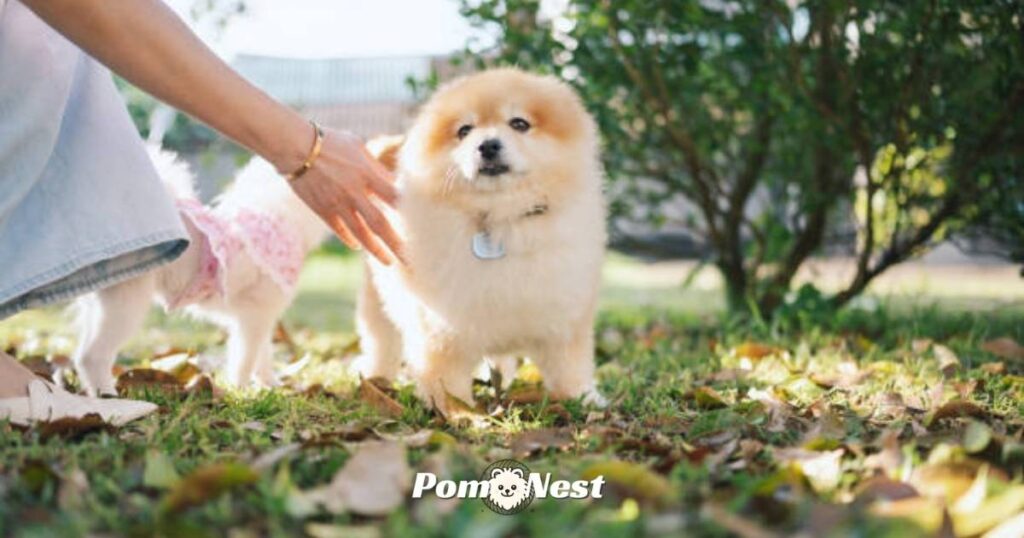
Your tone can communicate a whole range of ideas and emotions, even without using words. This is especially true when learning how to train a Pomeranian, where voice modulation comes into play. Speak in a steady, calm, and confident manner. This means not raising your voice and not sounding ambiguous.
For praise, use a higher and cheerful tone, and for corrections, a low firm tone. This is important in Pomeranian training since dogs are sensitive to changes in your energy. They can sense frustration and calmness.
Yelling commands to achieve a goal will not get you anywhere. It will only frighten your Pom. Use the commands “sit,” “stay,” and “come.” Your Pom will learn to act when you use these commands, so training a Pomeranian will become easier.
Negative body language, even in training, will impact your Pom. For example, a relaxed posture will be calming, while sudden movements can distract or frighten your Pom. For the best results, body language and tone of voice should be synchronized to achieve a goal.
⏱️ How Important is Timing in Pomeranian Dog Training?
Understanding how to train a Pomeranian efficiently requires an appreciation of the importance of timing. The timing of rewards and corrections shapes how a Pomeranian understands positive and negative behavior. Even brief delays may cause the dog to associate your reaction with an entirely different behavior.
Reward your Pomeranian immediately after he sits to demonstrate the value of swift reinforcement. Your dog learns to associate the command “sit” with the act of sitting, and the reward reinforces this connection. The importance of swift reinforcement cannot be overstated when it comes to the effective training of a Pomeranian. This is because, in contrast to humans, dogs learn through associative memory, not logical reasoning.
When misbehavior occurs, your dog needs to be corrected in the moment. Delayed punishment is futile because dogs exist in the moment and cannot comprehend your reasoning. This is a key tenet of effective training as opposed to frustration.
The timing of training sessions also affects your dog’s performance. Do not train immediately after meals or naps, as dogs are not mentally alert. Once you master the timing of your sessions, training a Pomeranian becomes a truly enjoyable activity.
Having a solid learning rhythm requires a blend of consistency, patience, and the ability to respond quickly. Your Pom sees the reward, and soon every command seems natural. That’s the secret to understanding how to train a Pomeranian successfully.
🐾 How to Train a Pomeranian Not to Bark
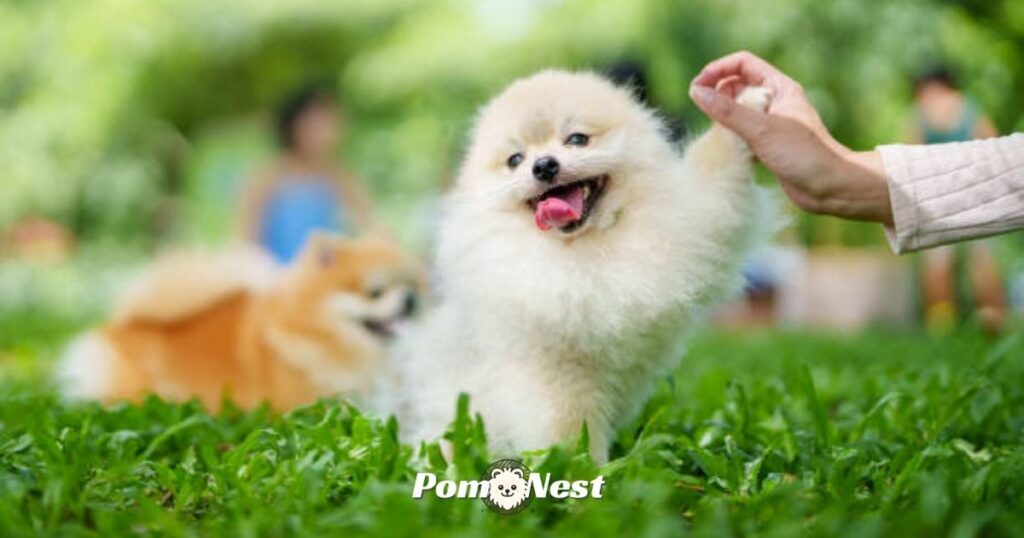
A crucial piece of learning how to train a Pomeranian is teaching them when not to bark. Poms do serve as alert little watchdogs, and barking serves as a warning or excitement response. Still, excessive barking can certainly escalate from cute to chaotic.
Take the time to identify your Pom’s barking triggers. Is it strangers, other dogs, or outside noises? Recognizing the triggers is the first step to manageable barking. This is how to train a Pomeranian effectively.
When your Pom barks, calm correction of the behavior is key — never shout. Say “quiet” in a firm yet gentle voice. Once prompt silence is achieved, reward the Pom immediately. That reward is the golden rule in having a Pomeranian.
Family members must align the commands and reactions. Conflicting instructions are very confusing to the dog. Remaining tranquil and steady will communicate to your Pom that silence leads to rewards. This is critical to teaching your Pomeranian the necessary manners for social settings.
Finally, do not forget to have activities planned for your Pom. A lack of stimulation is often the reason for excessive barking. To their daily routine, you can include more exercise, interactive toys, and periods of play. A dog is more at peace, and happier, when they are tired. This is the key to reducing the stress of training your Pomeranian.
Rewards in Pomeranian Dog Training
Rewards play an important role in how to train a Pomeranian successfully. Positive reinforcement dog training, when you key in rewards for good actions, works best for Pomeranians. This method avoids punishing the dog for bad actions.
Training treats for your Pom should be under the same criteria of being small, soft, and low-calorie to avoid overfeeding. Pomeranians are very social, so gentle petting and praise works as a reward if they shy away from food. Each Pom is unique, so you should find a way to get him excited.
In Pomeranian obedience training, administer rewards immediately after a Pom displays the target behavior. This reinforces the association and motivates repetition.
Make sure to keep training sessions short and enjoyable. Fast, consistent, and prompt rewards will motivate your Pom and facilitate learning. This will result in training becoming a joyful activity for the both of you.
Exercising Patience When Training a Pomeranian Dog
When learning how to train a Pomeranian, being patient is of utmost importance. These little fluff balls, although clever, can be rather temperamental, and a little stubborn, especially when it comes to obeying your commands. Taking the training steps too quickly can lead to a negative experience for both you and your Pomeranian.
Be sure to set reasonable and attainable goals when you begin training. Rather than expecting to achieve total compliance within the first few days, focus on consistent Pom obedience training and set manageable and attainable tasks. These training sessions should be kept to a maximum of 10 to 15 minute chunks as Pom’s have rather short attention spans.
Positive reinforcement in the form of treats and praise is a powerful motivator for Poms to sustain good behavior. There is no need to yell as this will damage the bond of trust and negatively impact progress.
Keep in mind, every Pom will learn at a different rate. Your bond will be strengthened the more you provide positive reinforcement, encouragement, and motivation. Gradually, your Pom will not only obey your commands, but also derive pleasure from training.
Finish Pomeranian Obedience Training in a Positive Way
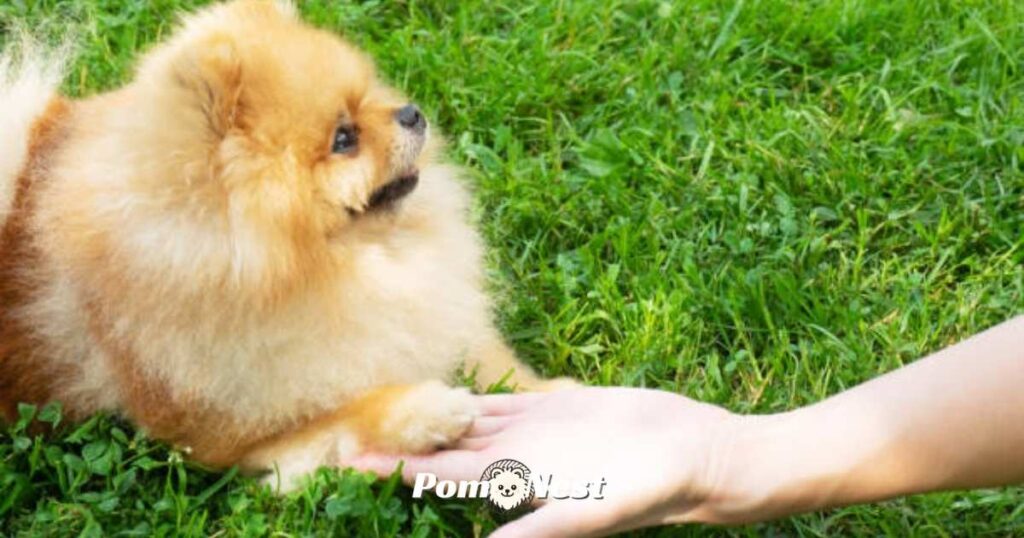
Finish the session on a positive note and help your dog associate how to train a Pomeranian with fun and success. When your Pom has difficulty responding to a command, do not end the session with an incomplete command. Instead, return to a command that they easily understand, like “sit” or “come” and reward them for that. This helps sustain their confidence and will encourage them to perform for the next session.
Make your praise for their small achievements enthusiastic, with soft pats and with yummy snacks, to reinforce positive training memories. Since dogs feel emotions, they will look forward to training if it ends in positive feelings.
You will create a tightly reinforced bond with your Pom by consistently ending each session on a good note. This is important because the primary aim of training your Pom should be play, and not create a negative environment.
How to Train a Pomeranian with the Proper Command
When learning how to train a Pomeranian, understanding the specific commands is vital. While dogs are not capable of understanding the language, they understand the commands and the feeling with which it is given. This means that each command needs to be consistently delivered with the same tone and banter.
Give concise and clear commands, like “Sit,” “Stay,” “Come,” and “Down”. Phrasing commands with long, polite phrases like “Please sit down now” will create confusion, so refrain from using it. Command with a tone of authority, yet in a friendly manner.
Ensuring that your body language aligns with your verbal commands is crucial. When instructing your Pom to “Stay,” for instance, use an outstretched hand in a stopping motion. With practice, your Pom will begin to recognize the gesture and command even from a considerable distance.
In your enthusiastic praise, keep it short — “Good boy!” or “Yes!” is effective when delivered with a cheerful spirit. Pomeranians are highly responsive to your emotions, so a happy and proud tone will make them want to cooperate.
The use of the same words and tone provides a clearer understanding of expectations. Repetition fosters trust, and that trust is the foundation of obedience.
10 Pomeranian Training Tips to Remember
- When learning how to train a Pomeranian, these smart tips will help you build trust and obedience quickly.
- Start early: Training should begin as soon as you get your Pom home. Early routines help you prevent bad habits before they establish themselves.
- Be consistent: Always use the same words, tone, and gestures for each command. Inconsistency will create confusion for your Pom.
- Use positive reinforcement: Reward good behavior with treats, praise, or play. Pomeranians respond to positive reinforcement and kindness, not to punishment.
- Keep sessions short: Attention and frustration are a concern, so the 5-10 minutes training sessions should be focused.
- Be patient: Stay relaxed and positive, as each Pom learns at their own pace. It may feel slow at times.
- Use your “trainer voice”: Speak each command clearly, and with emotion, but don’t shout. Yelling may scare your Pom.
- Socialize early: Build confidence and reduce anxiety by introducing your Pom to different people, sounds, and pets.
- Set clear boundaries: Consistent correction will help your dog learn the difference between what’s allowed and what isn’t.
- Mix up environments: Practice commands during dog walks and outside the home to help your Pom generalize learning.
- Always end with a positive note: Finish every session with praise or a treat to keep your Pom’s training joyful.
Training a Pomeranian can be simplified with an emphasis on patience, praise, and play. The Pomeranian’s training process can be simplified with a good amount of the time and patience. Pomeranians can be taught almost anything and commanded a number of actions.
The Sit Command

When learning how to train a Pomeranian, teaching your puppy the command ‘Sit’ is one of the first and most rewarding steps one takes to train a Pomeranian. The ‘Sit’ command is the foundation for obedience training.
Begin this training session with a small treat, holding it close to the puppy’s nose, then slowly moving it to the puppy’s head and just above it. When the puppy bottom lowers to the ground and sits, that is your cue to command ‘Sit’ and reward the puppy. Reward the Pomeranian for the correct action.
To get the command through to the Pomeranian, the reward needs to be given immediately after the action is performed. Over time the Pomeranian will learn the association of the action and the command ‘Sit and reward.
Make sure that the tone, and the action performed to command the Pomeranian remain the same. The Pomeranian learns the command better this way rapidement.
Most Pomeranians achieve “Sit” competence with consistent training within a week or two. On the other hand, every Pom is different. Stubborness or distractions are not issues, just be patient and try to keep Pom training light-hearted.
Most Pomeranians achieve “Sit” competence with consistent training within a week or two. On the other hand, every Pom is different. Stubborness or distractions are not issues, just be patient and try to keep Pom training light-hearted.
Most Pomeranians achieve “Sit” competence with consistent training within a week or two. On the other hand, every Pom is different. Stubborness or distractions are not issues, just be patient and try to keep Pom training light-hearted.
The Down Command
Hello dog training is not an academically “in-the-box” training. Learning how to train a Pomeranian helps you teach your dog a key milestone that builds discipline. It provides an essential outlet to calm your Pom in too stimulating situations.
After command “Sit” is accomplished, take a treat and hold it to the Pom’s nose, then gradually lower it to the Pom’s nose, then gradually lower it to the Pom’s nose, and li, and then gradually lower it to the Pom’s nose, then gradually. Lower it to the floor, then gradually to the floor.
Maintain a calm, confident firmness in your voice. Avoid swiftly repeating any commands, as this quick succession will not help your Pomeranian learn and may frustrate your pup. This technique teaches your Pom patience and helps reinforce focus and obedience.
Final Sessions
Schedule your training in short, five-minute bursts a few times a day. With practice, your Pom will learn the commands more quickly, and respond appropriately, without the need for a reward. This will be especially useful for visitations to the groomer or the vet, as your Pom will learn the importance of remaining still.
Down Command Troubleshooting
If your Pom does not respond to the “Down” command try to ensure the training area for your Pom is comfortable. Swap the training area for a softer surface, as many Pomeranians dislike being on hard and cold surfaces. If your Pom is still resistant, reward them for any small progress they make, such as lowering their head, so they may slowly learn to complete the full behavior.
Consistency is your best friend when training a Pomeranian. Finish each training session on a high note and your Pom will be more inclined to follow the command “Down” positively.
Training a Pomeranian to Stay
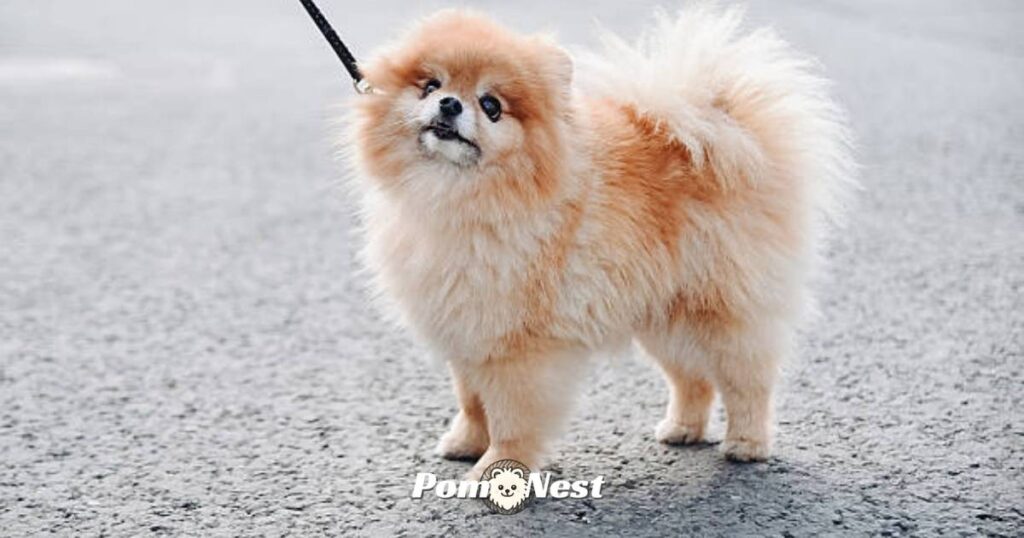
Teaching Pomeranians to stay is essential because it lays the groundwork for impulse control and attention. If you are wondering how to train a Pomeranian, start by having your Pom Sit for a few moments and practicing stay. Step back slowly, one step at a time. If your Pom goes completely stay, go back again and release the Pom and praise your Pom.
Training Pom to stay is a mental challenge for the Pom, and it is all about patience. Once your Pom goes for a few steps with a few seconds, reward your Pom. Remember to release your Pom with a command.
Teaching Pom to stay command increases control and overall safety. Pom can be within and outside controlled traffic settings. Arguably the greatest moments for this command are when a Pom is visiting a Vet, since traffic can be controlled, but new situations are always variable.
Training Pomeranians to Stay Troubleshooting
When a Pom breaks Stay command, simply focus the Pom back and refocus the Pom on the lesson. Stay command should be for 10 to 15 seconds, so once your Pom can do that, start with distracting notes.
Reward generously, maintaining an appropriately confident and friendly disposition. Ending each “Stay” session with an appreciation and treat lavished on a Pomeranian works to accentuate the idea that calmness is a state to which the organism might settle in, bringing with it the goodies. Over time, the “Stay” condition is achieved in a state of full autonomy, and deepens the Pomeranian’s attachment to the “Stay” command.
Teaching Your Pomeranian “Come”
Recall is the most important constituent when learning how to train a Pomeranian. It is the only means to guarantee the safety of the organism in a myriad of circumstances. Unlike active and even distracting spaces, start training in a quiet and enclosed area. Call your Pomeranian’s name and, in a friendly and cheerful way, say “Come” while kneeling at the level of the Pomeranian. When the organism approaches, appreciate it and offer a treat.
The first training sessions should be fun and not long. Under no circumstances should the command “Come” be used with punishment. Pomeranians that are expelled from attention should not be surprised if the attention lingers on the person. A long training leash works well in open spaces. Over time, your Pom will learn that coming to you always means something good.
In the case of an unresponsive Pom, you should gently leash guide the Pom, appreciate after they arrive, and repeat the command. Consistency, enthusiasm, and patience are the keys to strong recall training.
Teaching your Pomeranian “Come” Troubleshooting
In cases where your Pom does not move or seems distracted, you can ignite enthusiasm by making the Pom associate the name with excitement. You can try clapping, crouching, or taking a few steps back. Respond instantly with a reward when they do respond, even if it takes a while. Before taking your Pom outside, it can help to practice with your Pom indoors. Once your Pom has the attention and focus, it will be easier to be in the Pom’s line of sight.
For Pomeranians that tend to be stubborn, bring along the high-value treats or a toy to use. Stronging trust for the bond will be designed in the Pom with the command “Come” and when it is understood, it will certainly help with safe Pomeranian walks.
Pomeranian Trick Training
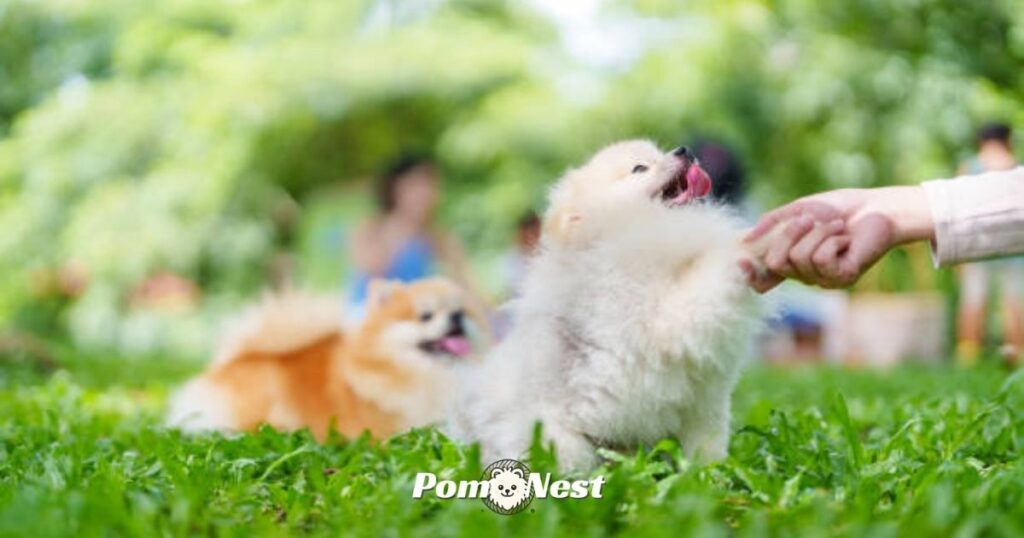
Once the basic commands are learned, learning how to train a Pomeranian can be even more enjoyable with simple tricks to perform. Trick training, especially, is a significant part of Pomeranian training in order for the Pomeranian to be emotionally stable. Easy tricks to start with are “shake,” “spin,” or “roll over.” Motivation and reward with small treats is extremely helpful in training.
To keep training sessions effective, keep them brief and energizing. Pomeranians have limited attention spans, so training should take no longer than two to three minutes. Pomeranians are very motivated and enjoy showing off once they associate a trick with a reward and praise. Always finish a training session with an accomplishment, so they are motivated for the next session.
Shaking a Paw (One or Both)
Start with your Pomeranian in the “sit” position. Take a treat in one hand, and while saying “shake,” gently lift one of their front paws. When they let you hold it, praise and reward them. This should be repeated a few times throughout the day. With the repetition offered, your Pomeranian will offer their paw on their own.
Once they learn the trick of one paw, you can move to the alternation trick. This builds confidence in your dog and strengthens their coordination. This trick is one of the many different bonding activities youcan do with your dog.
Pomeranian Trick Training Troubleshooting
With a Pomeranian, if they are refusing to perform the trick you asked, it is possible the distractions in the training environment are too much, or the treats you are using are not motivating. It is okay to take a break. Each Pom has their own schedule for learning, and the goal should be to help them using encouragement and determination.
Pomeranian Leash Training
Pomeranians are small dogs that love to walk and explore , so learning how to train a Pomeranian to walk on a leash is essential for their safety and your control outside. Even small dogs can be curious and adventurous. To begin, put a collar and leash on them and allow them to get used to it. After a little while, reward them for calmness with treats.
Once it becomes comfortable with the leash, take a few steps while encouraging it to follow and reward for it. Never drag or pull, call them and reward for walking together. You need to be persistent and positive, most importantly. With time, the Pomeranian will be trained that walking on a leash can be fun and it will be able to explore the offered surroundings.
Tips on Successful Puppy Pomeranian Leash Training
Have the basic training to be leash trained in a distraction free area. For example, use your backyard. Use short training periods and in time, slowly increase the duration of the walks. For calm and close walking, reward your puppy. Leash training is not about dominating a dog. It is about the bond and the communication you will use.
Pomeranian Behavioral Training
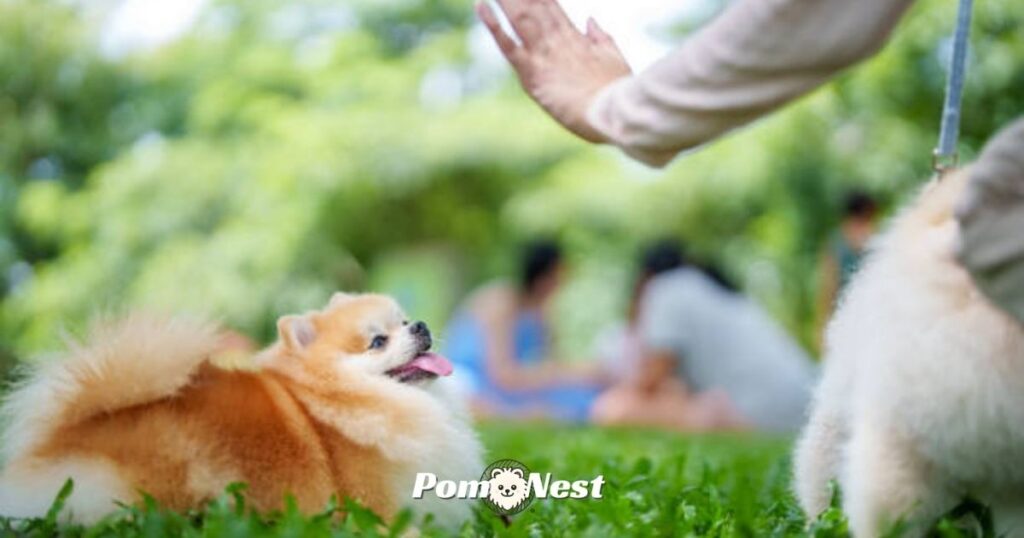
Behavior training is part of the training process for a Pomeranian since this breed tends to be a bit obstinate, vocal, and attention-seeking. Addressing these behaviors in the beginning will ensure that you have a happy and well-mannered Pom.
Start with the triggers. Do they bark, nip, or exhibit behaviors indicating anxiety? Recognizing the reason behind the behavior is the first step to developing a plan.
Pomeranian Barking and Aggression
When your Pom is barking excessively, do not yell since this will make the barking worse. Instead, remain calm, and use the verbal cue “Quiet”. Reward them for any moments of silence. For small aggression or nipping, let them redirect their energy to a chew toy, or engage in a mini play session. Fear-based aggression can be countered with proper socialization.
How to Stop Pomeranian Nipping and Biting
Puppies bite to explore their surroundings. However, consistent redirection will teach them proper behavior. If your Pom is biting you during play, firmly say “No”, and pause the game. Only resume the game when they have calmed down, in order to show them that biting will end the fun.
Pomeranian Body Language and Communication
Your Pom is capable of communicating important messages with their bodies. For example, a wagging tail, a full raised ear, or a stiff posture, can show you how they are feeling. Learning to read and recognize their body language will help you with proper responses to and form of.
Pomeranian Separation Anxiety Solutions
Pomeranians are affectionate companions and dislike lengthy solitude. Increase their alone time gradually, and always leave safe toys and calming sounds. Building patience and independence will also avoid anxiety and self-destructive behaviors.
Pomeranian Crate Training
Learning how to train a Pomeranian will help form a routine and manage behaviors. Crate training also assists Pomeranians in housebreaking. Having a crate also provides a Pomeranian with a personal safe space.
Select a crate that will allow your Pomeranian to stand, turn, and move around freely and have a cozy soft bed, a toy, and a treat to invite your Pomeranian into the crate.
How to Introduce the Crate
For your Pomeranian to feel comfortable with their crate, keep the crate door open, and allow for self exploration. Crate training involves positive reinforcement, reward your dog when they are calm and close to the crate.
Building Positive Associations
For your Pomeranian to see the crate positively and happily, feed them their meals in the crate. From there, close the door for progressively longer periods of time while you are in the same room with the crate.
Understanding Your Pom’s Crate and Potty Training
Pomeranians can be crate trained while they learn to relieve themselves in appropriate places. Dogs can be trained to learn not to eliminate waste in the space where they sleep. You can train your Pom to learn the appropriate commands for taking them outside after they wake from a nap, after a meal, or any other specified time during the day. They will eventually learn when and where it is appropriate to relieve themselves.
Lesson Description
Avoid using the crate for punishment. Your Pom should not be left in a crate when they are to be punished as it stands to be an area they can use for comfort. It is advisable to ensure all crate time is active as opposed to passive.
Teaching Your Pom New Tricks
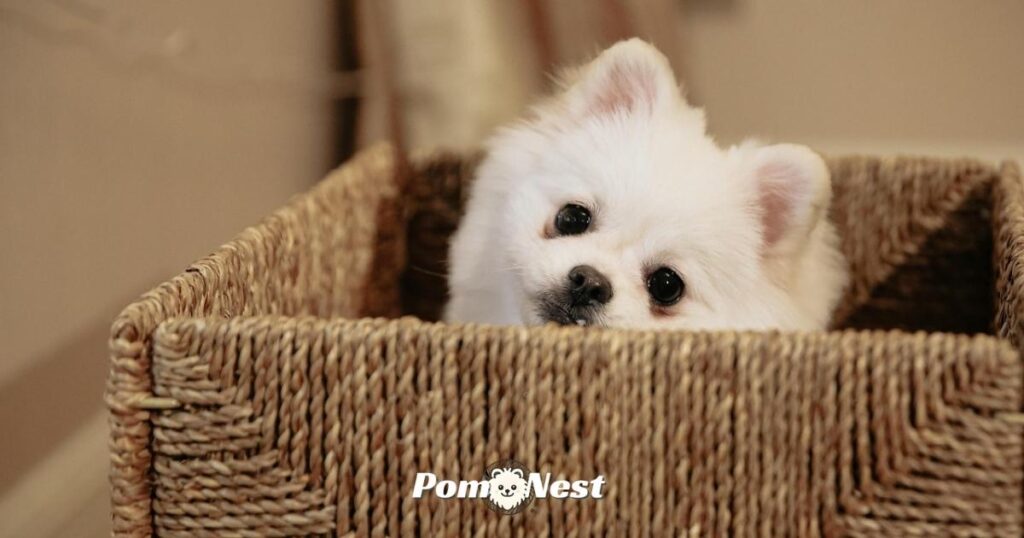
Training for a Pom’s advanced commands should be accompanied by fun activities. Training for commands needs to be accompanied by fun activities as it provides mental stimulation. You should try fun activities that reinforce commands that are elementary in nature i.e. in the “shake” command.
Active reinforcement for commands through a reward system can be done using small training treats and a pleasing tone. It is better to have shorter, focused training sessions as it will be more beneficial to you Pom.
It is advisable to always end on a high note to provide a sense of achievement which can be built on for the next session.
The activity will burn Pomeranians energy. Pomeranians enjoy playing fetch, and this will begin the process of them learning the activity. Start the fetch activity by tossing the toy a few feet. When they return, reward them. Start increasing the distance gradually over time.
Stay and fetch.
Once the Pom masters fetch, combine it with the stay command. Asking them to stay will teach them some impulse control and enforcing it with fun will increase the chances of them obeying.
Teaching Your Pomeranian to Speak.
This is teaching them to bark on command. Use a command word like “speak” and reward them for every time they bark. If your Pom barks a lot, this uncontrolled barking will help focus Pomeranian barking control. It will also teach them when it is appropriate to bark.
Teaching Your Pomeranian to sing.
This is for the Pomeranians that enjoy “singing” along with their owner to tunes. Play soft tunes and encourage your dog to join in. It will help showcase their fun personality and form a bond with them.
Final Thoughts on Pomeranian Training Tips.
Training a Pomeranian requires consistency positive reinforcement and plenty of love. There should be a reward for every step, no matter how small, to encourage them. Your Pom will appreciate this and it will help them strengthen their bond.
A happy Pomeranian is one that feels understood and is gently guided. During Pomeranian obedience training sessions, whether working on leash manners, fun tricks, or other activities, the owner should always try to keep sessions positive. When sessions are kept positive, the bond between the Pomeranian and the trainer is strengthened, making training easier.
Most importantly, the owner should focus on the training process. Teaching the Pomeranian is an activity that builds trust and communication.
More References:
YouTube Channels (Practical Video Training)
Zak George’s Dog Training Revolution – Positive reinforcement methods for small dogs.
FAQs
Pomeranians are clever and eager learners, but they can be somewhat stubborn. As a result, they do appreciate short and consistent training sessions that entail positive reinforcement, socialization, and clear routines.
Redirect the puppy’s mouthing toward appropriate chew toys. The puppy’s mouthing can be temporarily stopped by pausing the game and saying “ouch”. The puppy is then encouraged to soften its bite by praising the gentle mouthing.
Use a consistent schedule to take your Pomeranian to the toilet. You should also crate your Pomeranian, praise them immediately when they relieve themselves outdoors, clean indoor ‘accidents’ with an enzyme cleaner, and consult a vet if your Pomeranian has a sudden frequency of peeing.
Not really. The Pomeranian’s small bladder will require more frequent potty breaks. However, with consistent routines and positive reinforcement, the majority of Pomeranians will learn the routine rapidly.
For adult Pomeranians, the average pooping frequency is once to three times daily. A sudden change in frequency, consistency, or smell should be examined by a vet.
